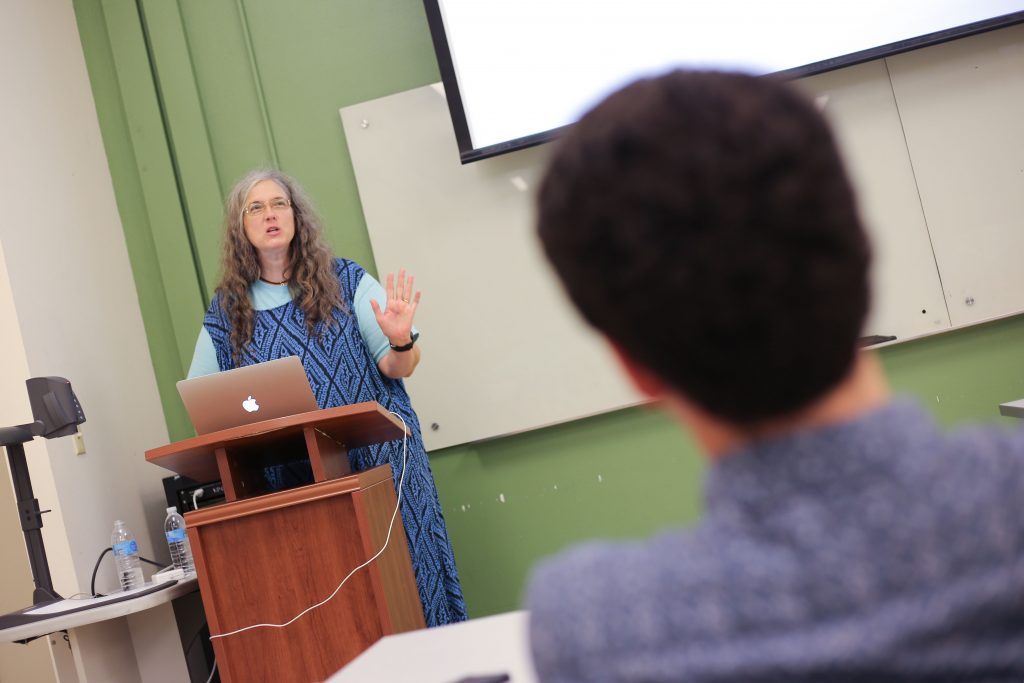
On Thursday evening, about 40 Binghamton University students gathered in the Old University Union to hear psychology professor Ann Merriwether deliver a talk about the realities of hook-up culture and sexuality on college campuses.
The talk was part of the BU Student Association’s (SA) new Spotlight series. Starting this week, the series is scheduled to run on the first Thursday of each month for the rest of the year with talks which are given by professors across various disciplines. Selected and voted upon by academic vice presidents from the different housing communities, the talks are designed to give students the opportunity to engage with faculty they would not normally be able to take classes with due to their rigorous academic or extracurricular schedules.
Adam Wilkes, the SA vice president for academic affairs (VPAA) and a junior double-majoring in economics and sociology, put the series together to give students the chance to explore other disciplines.
“These things are geared toward the campus community — the undergraduate community the SA represents in hopes of intellectual and scholastic intersectionality,” Wilkes said. “It’s also just to showcase some of the incredible faculty we have working here at Binghamton University.”
Merriwether’s talk focused on her work with an interdisciplinary research group which focuses on sexuality. Comprised of Sue Seibold-Simpson, a nurse practitioner who concentrates on contraceptive decision making; Sean Massey, an associate professor of the women, gender and sexuality studies department, who has a focus in social psychology; and former BU student Justin Garcia, ‘11, now a professor of biology at Indiana University, the group has been studying hookups at BU for about eight years.
The group spent several years asking students through surveys to define a hookup, receiving an array of answers before deciding on their own definition. According to Merriwether, they settled on “A hookup is a brief, uncommitted sexual encounter between individuals who are not romantic partners or dating each other.”
In looking at these encounters the group found differences in the way men and women view hookups. Merriwether theorized that this could be tied to media consumed at an early age, specifically pointing to the stories of Disney princesses and the impact they may have on young people.
“We’re telling kids all the time they’re growing up about this happily-ever-after version of relationships, and then as they grow up and transition into puberty and adulthood we start slamming them with all this information about sexual hookups,” Merriwether said. “They don’t abandon the soulmate thing, so particularly for women it creates a lot of conflict.”
While Merriwether did not deny that such relationships exist, she focused her talk on the ways modern media is geared toward hook-up culture for both men and women. According to Merriwether, this focus is present in all forms of media, including music, television and print media.
In researching these encounters, the group found that 67 percent of hookups at BU take place at parties, 57 percent in dorms, 10 percent in a bar or club, 4 percent in cars and 35 percent take place in an undisclosed location.
In the course of these encounters, the group’s research showed that 98 percent of hookups contain some form of kissing and 58 percent involved above-the-waist sexual touching, while 53 percent have below-the-waist sexual touching, 36 percent of people give oral sex during their hookups and 35 percent receive oral sex. 34 percent of encounters involve either anal or vaginal sexual intercourse.
Merriwether also spoke about the group’s desire for future research. Together, she said, they hope to study sexualities other than those typically present in similar studies. These would go beyond heterosexual or homosexual groups and look into more polyamorous and open relationships.


